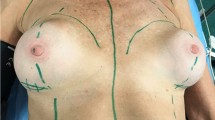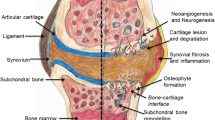Abstract
Background
Different surgical approaches are currently available to treat knee chondral defects. Microfracture is the most commonly applied, but it often leads to a mechanically inferior fibrocartilaginous tissue. To overcome this shortcoming, the Autologous, Matrix-Induced Chondrogenesis (AMIC) technique has been proposed. To further enhance the outcome of AMIC, the addition of haemoderivatives containing growth factors that stimulate cartilage healing has emerged as a new treatment method. Recently, a novel leucocyte–platelet-concentrated membrane (CLP-MB), highly enriched in platelets, monocytes/macrophages, fibrinogen, CD34+ and CD34+VEGFR-2+CD133+ cells, has been developed. Additionally, an injectable collagen scaffold (Cartifill) has been proposed as a replacement of the AMIC standard collagen membrane.
Aims
This preliminary study is aimed to evaluate the short-term safety and efficacy of the use of the CLP-MB membrane and injectable collagen scaffold when combined in single-step AMIC procedures for the treatment of knee chondral lesions.
Methods
Medical records of patients who underwent an AMIC procedure with the CLP-MB membrane combined with Cartifill were reviewed retrospectively. Follow-up assessments were conducted at 6 and 12 months after surgery. Clinical function was assessed on the basis of the International Knee Documentation Committee (IKDC) score. Pain was evaluated using the visual analogue scale (VAS).
Results
Twenty-five patients were identified as meeting the inclusion criteria. Mean IKDC and VAS scores significantly improved during the follow-up time. The postoperative course was uneventful.
Conclusions
AMIC combined with the CLP-MB membrane, and Cartifill seems to be a promising approach to treat knee chondral defects.





Similar content being viewed by others
References
Widuchowski W, Widuchowski J, Trzaska T (2007) Articular cartilage defects: study of 25,124 knee arthroscopies. Knee 14:177–182
Vaquero J, Forriol F (2012) Knee chondral injuries: clinical treatment strategies and experimental models. Injury 43:694–705
Erggelet C, Vavken P (2016) Microfracture for the treatment of cartilage defects in the knee joint—a golden standard? J Clin Orthop Trauma 7:145–152
Lee YHD, Suzer F, Thermann H (2014) Autologous matrix-induced chondrogenesis in the knee: a review. Cartilage 5:145–153
Mirza MZ, Swenson RD, Lynch SA (2015) Knee cartilage defect: marrow stimulating techniques. Curr Rev Musculoskelet Med 8:451–456
Marmotti A, Rossi R, Castoldi F et al (2015) PRP and articular cartilage: a clinical update. Biomed Res Int 2015:542502
Caloprisco G, Borean A, De Angeli S et al (2010) New method to produce hemocomponents for regenerative use from peripheral blood: integration among platelet growth factors monocytes and stem cells. Transfus Apher Sci 42:117–124
Steadman JR, Rodkey WG, Briggs KK (2002) Microfracture to treat full-thickness chondral defects: surgical technique, rehabilitation, and outcomes. J Knee Surg 15:170–176
Hunziker EB, Lippuner K, Keel MJB, Shintani N (2015) An educational review of cartilage repair: precepts & practice–myths & misconceptions–progress & prospects. Osteoarthr Cartil 23:334–350
Bark S, Piontek T, Behrens P et al (2014) Enhanced microfracture techniques in cartilage knee surgery: fact or fiction? World J Orthop 5:444–449
Gille J, Schuseil E, Wimmer J et al (2010) Mid-term results of autologous matrix-induced chondrogenesis for treatment of focal cartilage defects in the knee. Knee Surg Sports Traumatol Arthrosc 18:1456–1464
Kusano T, Jakob RP, Gautier E et al (2011) Treatment of isolated chondral and osteochondral defects in the knee by autologous matrix-induced chondrogenesis (AMIC). Knee Surg Sports Traumatol Arthrosc 20:2109–2115
Anders S, Volz M, Frick H, Gellissen J (2013) A randomized, controlled trial comparing autologous matrix-induced chondrogenesis (AMIC®) to microfracture: analysis of 1- and 2-year follow-up data of 2 centers. Open Orthop J 7:133–143
Wang Y, Yuan M, Guo Q et al (2015) Mesenchymal stem cells for treating articular cartilage defects and osteoarthritis. Cell Transplant 24:1661–1678
Chahla J, Dean CS, Moatshe G et al (2016) Concentrated bone marrow aspirate for the treatment of chondral injuries and osteoarthritis of the knee. Orthop J Sports Med 4:2325967115625481
Enea D, Cecconi S, Calcagno S et al (2015) One-step cartilage repair in the knee: collagen-covered microfracture and autologous bone marrow concentrate. A pilot study. Knee 22:30–35
Enea D, Cecconi S, Calcagno S et al (2013) Single-stage cartilage repair in the knee with microfracture covered with a resorbable polymer-based matrix and autologous bone marrow concentrate. Knee 20:562–569
Xie X, Zhang C, Tuan RS (2014) Biology of platelet-rich plasma and its clinical application in cartilage repair. Arthritis Res Ther 16:204
Guney A, Akar M, Karaman I et al (2013) Clinical outcomes of platelet rich plasma (PRP) as an adjunct to microfracture surgery in osteochondral lesions of the talus. Knee Surg Sports Traumatol Arthrosc 23:2384–2389
Lee GW, Son J-H, Kim J-D, Jung G-H (2013) Is platelet-rich plasma able to enhance the results of arthroscopic microfracture in early osteoarthritis and cartilage lesion over 40 years of age? Eur J Orthop Surg Traumatol 23:581–587
Manunta AF, Manconi A (2013) The treatment of chondral lesions of the knee with the microfracture technique and platelet-rich plasma. Joints 1:167–170
Milano G, Sanna Passino E, Deriu L et al (2010) The effect of platelet rich plasma combined with microfractures on the treatment of chondral defects: an experimental study in a sheep model. Osteoarthr Cartil 18:971–980
Buda R, Vannini F, Cavallo M et al (2013) One-step arthroscopic technique for the treatment of osteochondral lesions of the knee with bone-marrow-derived cells: three years results. Musculoskelet Surg 97:145–151
Dhollander AAM, Neve FD, Almqvist KF et al (2010) Autologous matrix-induced chondrogenesis combined with platelet-rich plasma gel: technical description and a five pilot patients report. Knee Surg Sports Traumatol Arthrosc 19:536–542
Siclari A, Mascaro G, Kaps C, Boux E (2014) A 5-year follow-up after cartilage repair in the knee using a platelet-rich plasma-immersed polymer-based implant. Open Orthop J 8:346–354
Kim J, Cho H, Young K et al (2015) In vivo animal study and clinical outcomes of autologous atelocollagen-induced chondrogenesis for osteochondral lesion treatment. J Orthop Surg Res 10:82
Kuroda R, Matsumoto T, Kawakami Y et al (2014) Clinical impact of circulating CD34-positive cells on bone regeneration and healing. Tissue Eng Part B Rev 20:190–199
Timmermans F, Plum J, Yöder MC et al (2009) Endothelial progenitor cells: identity defined? J Cell Mol Med 13:87–102
Anghelina M, Krishnan P, Moldovan L, Moldovan NI (2006) Monocytes/macrophages cooperate with progenitor cells during neovascularization and tissue repair. Am J Pathol 168:529–541
Hopper N, Wardale J, Brooks R et al (2015) Peripheral blood mononuclear cells enhance cartilage repair in in vivo osteochondral defect model. PLoS ONE 10:e0133937
Author information
Authors and Affiliations
Corresponding author
Ethics declarations
Conflict of interest
All authors declare that they have no conflict of interest.
Ethical approval
All procedures performed in studies involving human participants were in accordance with the ethical standards of the institutional and/or national research committee and with the 1964 Helsinki Declaration and its later amendments or comparable ethical standards.
Informed consent
Informed consent was obtained from all individual participants included in the study.
Rights and permissions
About this article
Cite this article
D’Antimo, C., Biggi, F., Borean, A. et al. Combining a novel leucocyte–platelet-concentrated membrane and an injectable collagen scaffold in a single-step AMIC procedure to treat chondral lesions of the knee: a preliminary retrospective study. Eur J Orthop Surg Traumatol 27, 673–681 (2017). https://doi.org/10.1007/s00590-016-1869-5
Received:
Accepted:
Published:
Issue Date:
DOI: https://doi.org/10.1007/s00590-016-1869-5




